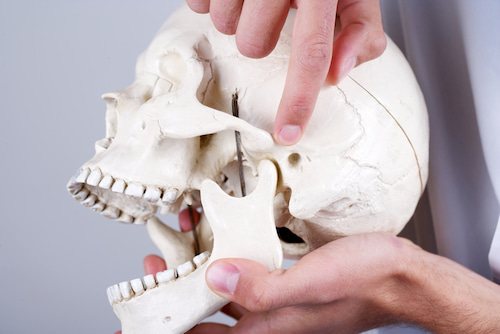
This joint is actually located at the base of the skull in front of the ear structure and connects the lower jaw (mandible) with the upper jaw (maxilla). Unlike most joints located in the body, the TMJ is unique in its structure, composed of a rounded protrusion of the mandible that sits against an indentation in the skull, and a disc-like structure made of a soft bone called cartilage found in between the two bones (articular disc).
These three parts of the TMJ are held together by ligaments originating from different parts of the head and neck to support the jaw and guide its movements. Several muscles are connected to those ligaments, and many aid in the motion of the lower jaw.
How Does it Work?
The TMJ works in two ways to open your mouth: The first way is like a hinge to simply open and close the mouth, just like a hinge on a door. The second way is a sliding motion called translation, wherein your lower jaw moves down and forward. This motion helps the TMJ to move backward and forward and from side to side for actions such as eating, yawning, and singing – some of the most common.
What Can Happen to the TMJ?
Like any other joint in the body, the TMJ can be fractured, swell and become sore, causing limited movement of the lower jaw and pain radiating to the head and neck area. A fracture to the actual articular disc is rare, but it can be displaced, causing severe pain and swelling. Unlike other joints such as knees and hips, arthritis of the TMJ is very rare, and hard to treat with anti-inflammatory drugs alone. Nonetheless, pain in the TMJ is often temporary and can be treated with a combination of ice then heat to relieve the sore ligaments and muscles surrounding the joint.
What About Grinding and Clenching?
Sometimes, pain in the TMJ can come from the teeth themselves, as opposed to the TMJ and surrounding ligaments.
Teeth grinding, for example, can become harmful if your teeth are misaligned, and certain movements cause the teeth to grind against each other, creating pain in the joint. Work or personal stress can be a source of aggressive jaw activity; and a general dentist, orthodontist, or prosthodontist are the most qualified people to look at your teeth and determine if this is the cause.
Clenching can also cause TMJ pain, and some patients exhibit this behavior at night while sleeping. Your dentist may prescribe a clear plastic bite/night guard, fabricated to help alleviate your symptoms after a thorough diagnosis has been made.
What If I Need Surgery on My TMJ?
Although rare, surgery is sometimes required to correct TMJ problems. A referral to an oral and maxillofacial surgeon is sometimes appropriate, and special imaging pictures of the joint may need to be taken to determine if surgery should be a part of your TMJ treatment. Often these procedures are as typical as the orthopedic treatment you’d receive for a knee injury.
How Do I Keep My TMJ in Good Health?
Just like keeping your teeth healthy, your TMJ should warrant regular visits to your dentist and dental hygienist to prevent complications during a routine dental exam. Proper brushing and the use of fluoridated toothpaste can help you reverse any wear to the enamel caused by a TMJ condition.
